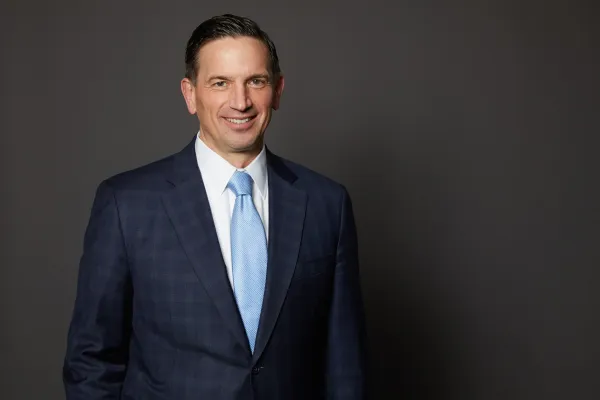GENUINE ALPHA GENERATORS are hard to find. That's why Mark Anson's departure came as such a shock to Hermes Pensions Management, which oversees $142 billion in assets for 240 clients, including pension funds, insurance companies and government entities in the U.K.
Anson, who jumped to Chicago-based Nuveen Investments at the beginning of September, had been orchestrating a sweeping new strategic investment project for Hermes's biggest client (and owner), the BT Pension Scheme, which has $75.4 billion in assets under management with the firm. The initiative -- to raise BT Pension Scheme's allocation to alternatives from 7 percent of the portfolio to 15 percent, or $11.3 billion -- was designed to dampen the volatility of the plan's equity holdings and reduce risk, while matching assets to liabilities more closely. But Anson's abrupt departure after only 21 months on the job stalled Hermes's momentum and left its trustees reeling.
"It has just been a terrible shock," acknowledges Richard Bernays, Hermes's chairman.
Anson, 47, announced in July that he was leaving Hermes to return to his hometown, where he would become president and executive director of investment services at Nuveen. Bernays immediately started looking, internally and externally, for a replacement. Sources say Anson's successor could be named as soon as next month.
Recent market instability has made Hermes's search for a new CEO even more urgent. U.K. plans have traditionally been slow to diversify their portfolios, preferring to invest heavily in publicly traded equities, while using investments in property and other real assets as hedges against inflation. But their approach is shifting dramatically, following the implementation of the Accounting Standards Board's Financial Reporting Standard 17, which was introduced in 2001 and went into full effect in 2005. FRS-17, as it is colloquially known, requires private sector defined-benefit-plan portfolios to be marked to market. British pension plans now must mitigate the volatility of their massive equity holdings. They can no longer rely on actuarial assumptions about possible rates of return, nor can they defer recognition of a plan's liabilities.
Not surprisingly, liability-driven investment strategies have taken off, and with them, unprecedented diversification into all types of alternatives. The scale and range of Hermes's diversification initiative under Anson was setting a new standard among British pension plans: In September 2006 the BT Pension Scheme agreed to reduce its exposure to publicly traded equities by 8 percentage points and boost its allocations to alternatives.
Beyond shockproofing BT's plan, Anson sought to diversify Hermes's asset base by attracting new external clients. Hermes has long had third-party investors -- pension funds, insurance companies, government entities and even charities and endowments -- but the sheer size of BT Pension Scheme's portfolio, the largest in the U.K., meant that most of the firm's capacity was taken by its founding client. Post FRS-17, Anson saw the chance to design innovative funds to revitalize Hermes's asset management business and attract more third-party investment.
To that end, he shook up Hermes's management approach and investing processes, hiring more than half a dozen senior portfolio specialists to help reposition the firm. The new hires were meant to augment Hermes's growing portfolios of alternatives as well as its shareholder-activist investing efforts. Among other moves: In mid-July, Hermes off-loaded its passive index-tracking business to London-based Legal & General Investment Management to free up resources for its dynamic -- and profitable -- corporate governance and stewardship services.
Bernays insists that Hermes will continue to pursue its portfolio diversification and other strategic investment initiatives without hesitation. "The team is now in place, and we are tackling this challenge with gusto," he says.
Still Hermes has had to put its long-range development plans on hold until a new CEO takes the helm. "Anson's departure was a great blow to Hermes," says John Duffield, founder and chairman of London-based alternatives group New Star Asset Management, who knows Bernays well and has long been one of Hermes's competitors. "Mark did a tremendous job in the relatively short period of time that he was there, and finding his successor will be very difficult -- it just isn't easy to replace a person of that intelligence, integrity and experience."
FOR ANSON, FAMILY FACTORS PLAYED a big role in his move: In May his father fell ill, but Anson was unable to return home before he died. Then, a few weeks later, Anson's father-in-law was diagnosed with a serious illness. The strain of coping with two family crises from overseas took a toll. In June, when Anson got a call from an executive recruiter asking if he'd be interested in moving to Chicago to join asset management firm Nuveen Investments, he was receptive.
"I already knew Nuveen well," says the lanky, hyperarticulate Midwesterner, who has a law degree from Northwestern University's School of Law, and a master's degree and Ph.D. in finance from Columbia University's Graduate School of Business. "I'd talked to them when I was still at CalPERS, but the timing wasn't right."
This time it was. Adding to the appeal: publicly traded Nuveen agreed in June to a buyout led by private equity firm Madison Dearborn Partners. Expected to close this fall, the deal will bring an infusion of fresh capital and allow Anson to build the business away from the close scrutiny of Wall Street.
Anson himself spent many years on Wall Street, first as a swaps, options, futures and structured products expert at Salomon Brothers' equity derivatives desk and later as a portfolio manager at Oppenheimer Funds. But he earned his stellar reputation in public service: At the California Public Employees' Retirement System (with $246.4 billion in assets under management, the largest pension plan in the U.S.), Anson played a key role in integrating hedge funds and other alternative assets -- private equity, infrastructure and commodities -- into the plan's portfolio. He also took the lead in initiating many of CalPERS's corporate governance initiatives, as the U.S. pension giant earned a reputation as a fearsome shareholder activist. During his tenure as CalPERS's CIO, from 2001 to 2005, assets soared from $127 billion to $220 billion, while he implemented the concept of separating alpha and beta in the investment portfolio, a process that generated $13.2 billion in excess returns.
"Mark is a very smart guy and an excellent manager of people and portfolios," says Christianna (Christy) Wood, a senior investment officer at CalPERS who has known Anson for years and now oversees the $160 billion global equity unit (CalPERS's hedge fund program, domestic long-short program, corporate governance, cash management and manager development programs are also in her purview). "When you have someone like that, who can make rational decisions and work hard to pull an organization together, the results really show."
Anson was transforming Hermes along the same lines before he left. A top priority -- even before the credit markets began to deteriorate -- was to imbue Hermes's investment processes with even greater quantitative discipline and to go beyond the mere separation of alpha and beta to identify independent, uncorrelated sources. "Most investors love to talk about alpha versus beta as if they were diametrically opposed points on an economic compass," Anson says. "The truth is that there is a continuum between pure beta at one end and pure alpha at the other end. The trick for every asset manager is to decide where they want to position themselves on the alpha/beta continuum."
The quantitative model that he was developing was based on the idea of a progression, or spectrum, of passive to active asset management. At one end of the spectrum is classic beta, the capital-market beta used by index trackers. Moving toward the middle of the spectrum, toward more-active management, investors have access to bespoke beta, represented by exchange-traded funds that slice and dice the broader market into smaller bits of systemic risk. Even farther along the spectrum toward active management, Anson says, are the fundamental beta experts, represented by fundamental indexers, followed by the mavens of cheap beta -- including convertible arbitrage managers -- who, Anson says, break down convertible bonds into their component beta risks and hedge out the expensive beta components. Anson places active beta, like 130/30 funds, next on the spectrum. Finally, he puts actively managed, high alpha-content funds -- including shareholder activists -- at the far end of the continuum.
True alpha originators are increasingly difficult to find. Despite his record as a cutting-edge investor in hedge funds, Anson is skeptical that most hedge fund managers are actually delivering alpha; investors in the vast majority of funds, he says, are paying huge sums of money for the privilege of buying market exposure. At no time has that been more evident than in the wake of the recent upheaval in the credit markets, which rocked the public equities markets and caused major losses at more than half a dozen hedge funds.
"Pure alpha, as we once knew it, is becoming increasingly scarce," Anson says. "When you have $1.7 trillion invested in hedge funds globally, and all of those market participants coming in and chasing alpha, you begin to develop systemic risk factors that look a lot more like beta than they do like alpha."
Anson's quantitative discipline was yielding results: In mid-May, the BT Pension Scheme announced that its investment returns of 12.7 percent for 2006 outperformed its benchmark return of 11.3 percent and handily outstripped the average investment return of 10.7 percent for the 50 largest U.K. pension funds last year, as calculated by Edinburgh-based market research firm WM Co.
Anson did, however, leave a strong team in place: Roger Gray, former head of UBS Asset Management in Switzerland, was hired in September 2006 to replace the former chief investment officer, Nick Mustoe, who left for Pictet Asset Management after failing to win the CEO job at Hermes; Nigel Labram, former head of commodities investing, was promoted in the fall of 2006 to executive director of strategy and alternatives, replacing former head of alternatives James Walsh, who had recently moved to the U.S. to become the CIO of Cornell University.
The 54-year-old Labram previously worked at UBS and Rabobank setting up and running their global commodities derivatives operations. He now oversees Hermes's burgeoning portfolio of alternatives. Assuming that Hermes continues on its current course, doubling its alternatives allocation, the team will need to find investments to meet targets of 5 percent in hedge funds, 5 percent in private equity, 3 percent in commodities and 2 percent to be held in reserve for opportunistic investments.
"Having Mark at the helm was terrific, because he so understood alternatives it was like pushing against an open door," Labram says. "But a great deal of work in alternatives was already being done here before he arrived, and I have no doubt that it will continue."
Although Hermes was one of the earliest British pension-asset management firms to invest in alternatives, the firm started to invest directly in hedge funds only recently, in November 2004, when it set up its internal fund of hedge funds, the Hermes Absolute Return Fund. The fund, which now has $1.93 billion under management as of June 30, has delivered an annualized return of 8.3 percent since inception in June 2004 through June 2007 -- just edging out Hedge Fund Research's global hedge fund index, at 8.1 percent during the same period. To date, however, Hermes has needed most of that fund's capacity for BTPS; only one other investor, the South Yorkshire Pension Authority, has a stake in it -- and a small one at that.
Hermes moved cautiously in developing alternative investment strategies, especially investing in hedge funds. It wanted to build its own team of specialists and experts in-house and had to face the relative difficulty of putting vast new sums of money to work in hard-to-gauge investment strategies.
"We've had to move very deliberately because it takes a long time to get these sorts of huge, $100 million exposures," says Labram. "We spent quite a lot of time setting up our own process here, hiring staff and making sure that our methodology was sufficiently resilient."
Like many pension-asset investors, Labram and his team still look at Hermes's portfolio of alternatives -- hedge fund strategies, private equity, infrastructure, active commodities strategies, tactical asset allocations and alternative betas (such as volatility) -- as satellites to Hermes's low-cost, core market exposures in equity and fixed income. But they also try to ensure that their allocations to various alternative strategies are uncorrelated with one another. Labram and his team are using their reserve capital -- the 2 percent set aside for opportunistic investments -- to find managers running innovative alpha-generating strategies, such as various niche investment strategies in distressed credit.
Notably, Hermes's Absolute Return Fund is not invested in any manager focused on structured finance, such as the collateralized debt obligations that have caused investment banks to hemorrhage capital. The only credit exposure for fund of hedge funds comes through its event-driven or distressed-investing managers; typically, Labram says, those managers' exposure has been on the short side.
"Many of the best investment opportunities right now can be found in the gaps between broadly accepted, categorical asset classes, where some of the most innovative managers are doing arbitrage," Labram says. "Even though their strategies don't fit easily within any of our portfolios, we want to make sure that we don't block our own ability to invest with them, which is why we've created this portfolio of what I call 'alternative alternatives.'"
Diversification can take many forms. Historically, Hermes has been seen as a conservative British institution with a genteel, civil-service-style culture; it took a risk in hiring the hard-driving American.
"For an English investment firm like Hermes to take on an American CEO was really quite unusual," says New Star's Duffield. "While it isn't unprecedented in London, because there are a lot of foreigners working in financial services and investment banking, very few of them are running big, quintessentially British institutions."
As of late September, Hermes's chairman, Bernays, was clearly hoping to find another candidate like Anson -- at once politically savvy and academically sound -- who might yet be able to drive the expansion of the firm into new territory. "We've had extremely good investment performance, and one of the challenges we face is to try and continue to develop our third-party business," Bernays says. "While I was very sad to see Mark go, his departure wasn't a total disaster for Hermes, thankfully, because we do have a very good team now to carry the business forward."
Mark Anson, 47, announced in July that he was leaving Hermes to return to his hometown of Chicago
THE FACTS
NAME: Hermes Pensions Management
FORMED: 1983
OWNER: BT Pension Scheme
WHAT WE KNOW: Since 1997 -- when Hermes first allowed third-party investment -- BT Pension Scheme has had an annualized return on its investments of 9.3 percent, besting the 8.4 percent average annual investment return of the 50 biggest pension firms in the U.K.





